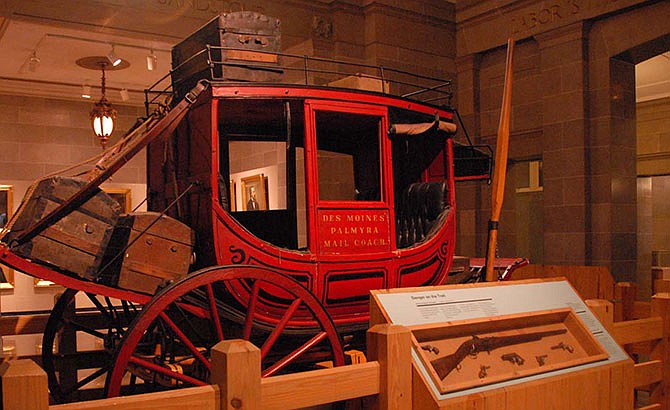A bugling from the east near Bogg's Hill in the late afternoon informed Jefferson City residents in the late 1830s that the stagecoach with mail and travelers was on its way.
Shop keepers closed their storefronts and counting rooms to meet the wagon outside the McCarty House, which once stood at 120 McCarty St. Curious socialites were escorted to the hub, as well. And it was quite the affair every day to peek inside the coach and listen as names were called to pick up their post.
In James Ford's "History of Jefferson City," he said the carriage held six passengers, with room for extras to ride with the driver or on top. It was pulled by four horses and behind the driver's seat was a "leather contrivance called the "boot'" for mail and baggage.
In the beginning, the driver was owner and entrepreneur Thomas Lawson Price. In 1838, he and fellow Virginian pioneer Burr Harrison McCarty established the first stagecoach line from St. Louis to the Capital City.
Also, they held the mail contract, Cole County Historical Society records said.
Early in statehood, the mail contracts were lucrative and political. Local historian Ken Winn suggested Price was able to secure the 1838 mail contract through his association with such influential men as Sen. Thomas Hart Benton and simply because of his wealth.
"I'm not surprised Price got the contract," Winn said. "He was a rich guy when he was young."
He may have died while worth more than $500,000 in 1870, but he moved his family fortune west in 1831 after the death of his father in Virginia. Where the average slave-holder in Missouri had two slaves, Price had nearly 80 in Cole and Moniteau counties.
The main way of reaching Jefferson City, which was artificially and deliberately created near the confluence of two riverways, was by the water, leaving it pretty isolated, Winn said.
The St. Louis to Jefferson City stagecoach route was important first for political reasons, Winn said.
Before the railroad, the stagecoach provided a consistent means of travel, though they "encountered many difficulties with Indians, bandits and bad roads," Mrs. Charles Dewey wrote on behalf of the Cole County Historical Society in the Nov. 21, 1941, newspaper.
"A sturdy and resourceful young man, Price invested in a stage coach and horses which he drove himself from Jefferson City to St. Louis and back again," Dewey said. "Soon, he was owner of this and other stage lines.
"And, when the stage coach was superseded by the railroad car, he became a builder of railroads."
The McCarty and Price stagecoach line entered town on the St. Louis Road and then High Street to Jefferson, where it turned south to McCarty, Gensky said.
"I assume that Burr McCarty put the horses in his stable behind his hotel, located on McCarty Street between Madison and Jefferson streets," Gensky said.
A "commodious home," the Illustrated Sketchbook said, the McCarty House closed only for a few days in its 68-year operation, during the threat of invasion by Confederate Gen. Sterling Price in the fall of 1865. Because it was the largest hotel at the time in the city, the Union army commandeered the rooms for a hospital and cut holes in the walls for fortification.
McCarty Street was named for the hotel operator, a "public-spirited citizen ... always with a kind word and smile for all," the Illustrated Sketchbook described.
However, his one-time partner, Price, does not have a street named for him, despite being "a wealthy leading member of one of the most prominent and influential families of the state," according to the Illustrated Sketchbook.
Price also served the first two terms as Jefferson City mayor and was lieutenant governor.
As the stage business was fading, he jumped into railroad construction, building the C&A Railroad, a part of the Missouri Pacific Railroad from Cedar City to Mexico.

